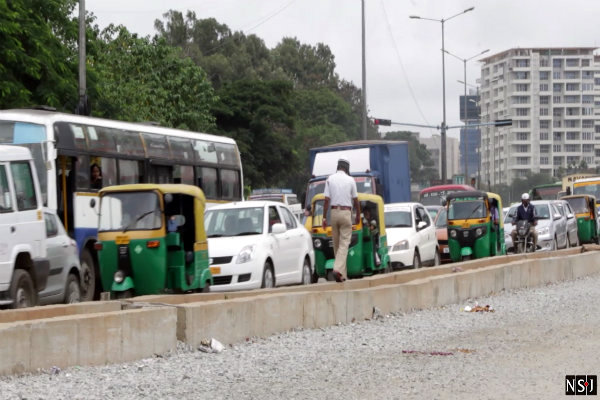
Aathira K and Nasreen Sattar
NSoJ Bureau
Peak hour on any given day at the Peenya junction sees vehicles, private and public, jostling for space and often nudging each other off the concretised road onto the side path. Grumpy drivers in BMTC buses and motorists in swanky sedans and bikers gunning furiously, honk on with equal impatience. Amidst the commotion generated by commuters converging from five directions, wary pedestrians dash dangerously across the road at regular intervals. Most have covered their faces with flimsy dupattas or handkerchiefs, in a laughable attempt to avoid breathing in the pollutant-laden air. But the clouds of dust and debris that the vehicles whizzing by leave in their wake, show this to be a supremely futile exercise.
This intersection is one of the most congested areas of Bangalore. According to a report published by Green Peace, the pollution level here is 26 times higher than the limit prescribed as safe by the World Health Organization. Simply breathing in this toxic air is hazardous to health. What’s more, the difference in air quality is obvious even to a layman approaching the junction.
Toxic air
The impact on health owing to air pollution has been well-documented. Just how much of an impact this vehicular pollution has, is obvious from the number of persons complaining of breathing difficulties in the city. According to a survey conducted in 2015 by Breathe Blue ’15 via Lung Health Screening Tests, 14 % of school-going kids in Bengaluru have developed ailments due to air pollution. Diesel has been classified as class I carcinogen by the WHO. This is worrying considering the fact that there are 58 lakh vehicles in the city with one vehicle for every two people, as per the study conducted by the Centre for Science and Environment in 2014-15.
Pulmonologist, Dr. Hirenappa B. Udnur of the Columbia Asia Hospital, Hebbal, sees an increasing number of such patients on a daily basis. “Sulphur dioxide, nitrous oxide are present in the air due to vehicular exhaustion. Over 4000 particles exist in the atmosphere, some of which cause serious health problems. Lung diseases, bronchitis and recurrent asthma attacks are quite common in the city,” he told the National School of Journalism (NSoJ). He explained the toxicity of Suspended Particulate Matter which are of levels PM 2.5 and PM 10 in Bengaluru. Particulate matter below 10 microns are minuscule and hence easily absorbed by the lungs.
Toughest on those who man the traffic
Traffic cops face the maximum risk of exposure to the lethal particles in the air. In a sample screening of 160 traffic policemen, the Delhi-based BLK Super Speciality Hospital found that 25% of them suffer from breathing disorders.
Mahadeva and JP Rakesh of the Peenya Traffic Police Station have seen the worst of pollution at this junction. Both unanimously stated that the Regional Transport Office must cancel the registration of old vehicles. Rakesh offers an interesting solution to arrest the congestion. “Software companies should opt for a couple of Volvo buses rather than 50 cabs as a mode of conveyance for its employees,” he said. He also points out that noise pollution is also an issue at Peenya with incessant honking which “blow the eardrums”. The Ministry of Environment and Forests stipulates permissible noise levels at 55 decibels in a residential area and at 65 in a commercial zone. Places such as MG Road, Marathahalli, Kempegowda bus stand, however, have crossed the noise level of 100 decibels, constant exposure to which can result in permanent hearing loss.
“The government could consider measures to control the number of vehicles owned by each family,” Mahadeva added but did not elaborate on how this can be legally enforced.
City or the citizen: Who is to blame?
Did the city bring this upon itself or is the administration to be blamed? Subhodith Bhattacharya, who usually commutes via public transport, believes citizens are responsible for the crisis, not the government. “We should use public transport as far as possible. Every other person travels by his/her own vehicle, which contributes to the traffic,” he said.
Dr. Udnur concurred with Bhattacharya’s point on choosing public transport. He recommends inspection of vehicles for emission and planned development of cities.
He also has reason to believe that living outside the city is healthier. “Though I can’t prove it, those who live outside Bangalore or in rural area are likely to live for five years more than someone who lives in the city,” he stated.
Corroborating this statement is Shubhangi, a resident of Hebbal. “While I was residing in the Central Business District, I faced persistent headaches and breathing problems. There is a marked improvement in my health after I moved to this suburban area,” she told NSoJ.
However, unlike Shubhangi, city-dwellers told NSoJ that they do not want to shift to the suburbs or compromise on the perks of a happening lifestyle within the city. Most are aware that increasing traffic and air pollution can severely impact health. But not many are willing to fight for their right to clean air.
I am from Bangladesh and I know how it feels 😥
LikeLike